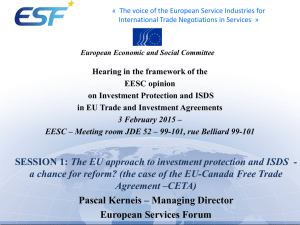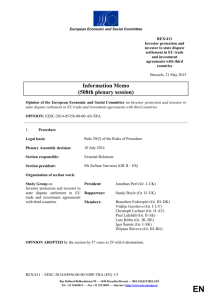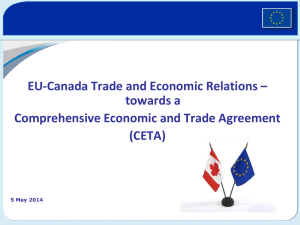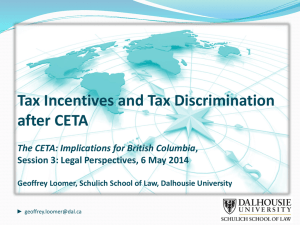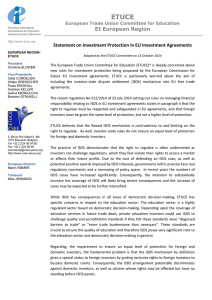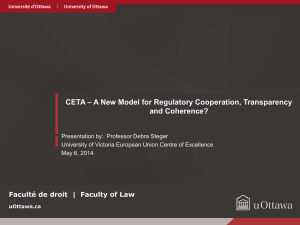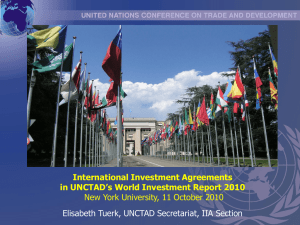Arbitrators
advertisement
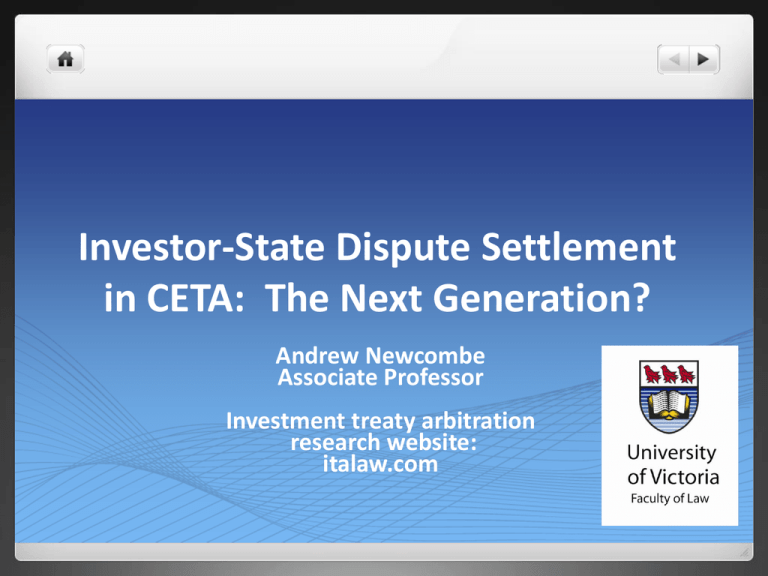
Investor-State Dispute Settlement in CETA: The Next Generation? Andrew Newcombe Associate Professor Investment treaty arbitration research website: italaw.com Outline Introduction to investor-state dispute settlement (ISDS) in investment treaties—rationales and concerns Current ISDS state of play EU BITs compared to Canadian Model FIPA What CETA borrows from NAFTA/US BITs/Canadian FIPAs Innovations in CETA ISDS Where CETA does not boldly go … ISDS in CETA: The next generation? Investor-state dispute settlement State agrees to arbitrate breaches of investment obligations under international arbitration rules Ad hoc tribunal of three arbitrators determines if state has breached investment obligations Tribunal can award damages, costs and interest Arbitral award can only be reviewed on very limited procedural grounds Award is enforceable under international and domestic law Rationales for ISDS Investment protection backed-up by ISDS promotes investment; credible commitments lower political risk resulting in greater and cheaper FDI (BITs lower risk premiums) Domestic courts may not be in a position to enforce government commitments to foreign investors: not independent and/or treaty obligations not enforceable in domestic courts (i.e. NAFTA – no cause of action in Canadian courts) Benefits of depoliticization of foreign investment disputes; powerful home state of investors will/must refrain from using economic, political and forceful means of dispute settlement to protect nationals and companies Promotes rule of law; good governance; accountability Concerns with ISDS Legitimacy: ad hoc tribunal of three arbitrators assessing state conduct Transparency: private and confidential proceedings Nationality planning: use corporate structuring to obtain treaty benefits Consistency of arbitral decisions regarding similar treaty provisions Erroneous decisions cannot be corrected Arbitrator independence and impartiality Financial stakes Current ISDS state of play (end of 2013) 568 known investment treaty cases involving 98 different respondent states Respondent states by development status: 57% developing; 27% developed; 16% transition 274 concluded cases: 43% in favour of respondent state; 31% in favour of investor; 26% settled In 2013 foreign investors initiated 57 known claims – second most active year on record Claims by Canadian and EU Investors (as of end of 2013) Claimants from EU lead: 299 cases or 53% of all cases Netherlands (61); UK (43); Germany (32) US is next with 127 claimants or 22% of all cases Canada (5th place); claimants from Canada have brought 32 cases or 5.6% of all cases In 2013, of 57 new claims, most frequent claimants are from EU Netherlands (7); Germany (6); Luxembourg (6) Claims against Canada and EU member states (I) Most frequent respondents: - 3rd place: Czech Republic (27 cases) - 6th place: Canada (22 cases) (Canada has lost 3 cases, 2 settled) - 8th place: Poland (16 cases) - 12th place: Hungary (12 cases) - 15th place: Slovakia (11 cases - 16th place: Romania (9 cases) - 18th place: Spain (9 cases) Claims against Canada and EU member states (II) – In 2013 24 claims against EU member states (Czech Republic (7); Spain (6)) 23 claims brought by EU nationals against other EU member states based on intra-EU BITs or the Energy Charter Treaty 3 NAFTA claims against Canada in 2013 Lone Pine: Cancellation of gas explorations permits by Quebec “fracking ban” Windstream: Ontario moratorium on offshore wind farms Eli Lily: Claim for invalidation of patents for two drugs EU BITs compared to Canadian Model FIPA EU BITs: one or two paragraph provision providing general consent to arbitrate investment disputes under international arbitration rules Article 9, Dutch Model BIT Each Contracting Party hereby consents to submit any legal dispute arising between that Contracting Party and a national of the other Contracting Party concerning an investment of that national in the territory of the former Contracting Party to the International Centre for Settlement of Investment Disputes for settlement by conciliation or arbitration under the Convention on the Settlement of Investment Disputes between States and Nationals of other States, opened for signature at Washington on 18 March 1965. A legal person which is a national of one Contracting Party and which before such a dispute arises is controlled by nationals of the other Contracting Party shall, in accordance with Article 25 (2) (b) of the Convention, for the purpose of the Convention be treated as a national of the other Contracting Party. EU BITs compared to Canadian Model FIPA Canadian 2004 model: expands on extensive ISDS innovations in NAFTA; incorporates lessons from NAFTA and addresses many of the concerns with ISDS (20 pages of legal text) CETA Draft ISDS text (April 2014): incorporates many of the provisions common in US and Canadian models with some additional (but relatively minor) innovations (15 pages of legal text) What CETA borrows from NAFTA and recent US BITs/Canadian FIPAs Consultations and information: requirement to request consultations and provide information regarding claim Time limits: request for consultations must be made within three years of knowledge of alleged breach Waiver: investor must waive right to submit dispute to local courts; avoids concurrent proceedings Consolidation: Multiple claims having a common question of law or fact and arising out of the same events can be consolidated What CETA borrows from NAFTA and recent US BITs/Canadian FIPAs (II) Arbitrators: must have experience in public international law and are subject to a code of conduct (to be developed) Transparency: ISDS documents to be made public, hearings open to the public, non-disputing parties can make submissions Remedies: limited to damages or restitution of property (no declaratory relief, i.e. change law or policy) Interpretations: Treaty parties can adopt binding interpretations of investment obligations that are binding on a tribunal ISDS innovations in CETA (I) Mediation: express provision on mediation(only if agreement of both disputing parties) Extension of time: time limits for bringing claim are extended if investors seeks remedies in local courts Sole arbitrator: respondent state to give sympathetic consideration for request for sole arbitrator where the investor is a small or medium-sized enterprise or the compensation or damages claimed are relatively low Roster of arbitrators: Appointment from roster when parties have not agreed to constitution of tribunal ISDS innovations in CETA (II) Frivolous claims: Procedures to deal with claims manifestly without legal merit and claims unfounded as a matter of law Appellate mechanism: parties to consult on whether, and if so, under what conditions, an appellate mechanism could be created Arbitrator fees: subject to ICSID rates Where CETA does not boldly go…. Mandatory alternative dispute resolution Exhaustion of local remedies Screening of investor claims by treaty parties Instituting an appeals mechanism Standing international investment court Abandoning ISDS and return to state-to-state dispute settlement Integrate investment protection within WTO system ISDS in CETA: The Next Generation? Investment Chapter of CETA provides a template for the (invisible) EU Model BIT (2014) Question to debate is not whether ISDS is necessary in CETA, but whether it is in the overall interests of Canada and EU to support ISDS in international investment agreements Both Canada and EU have significant outward FDI; “offensive” interests in protecting investors abroad “Defensive” interests as a potential respondent state can be managed by refining substantive and procedural protections
